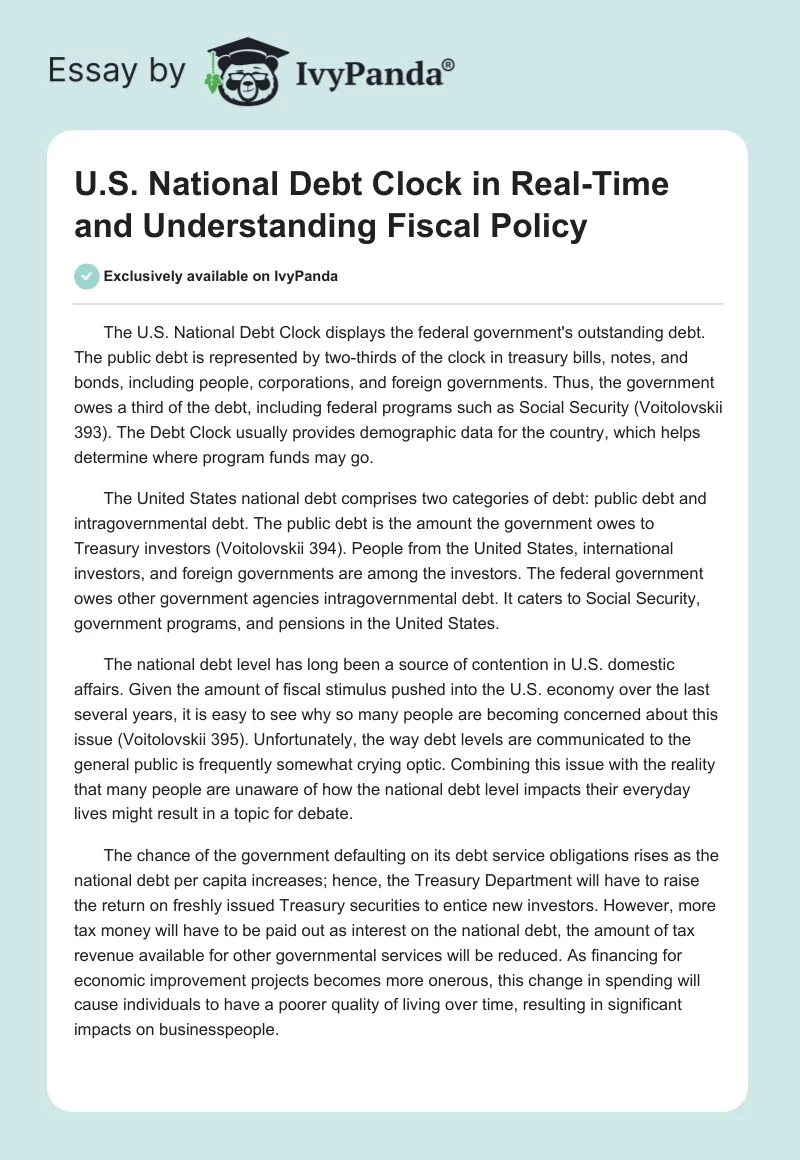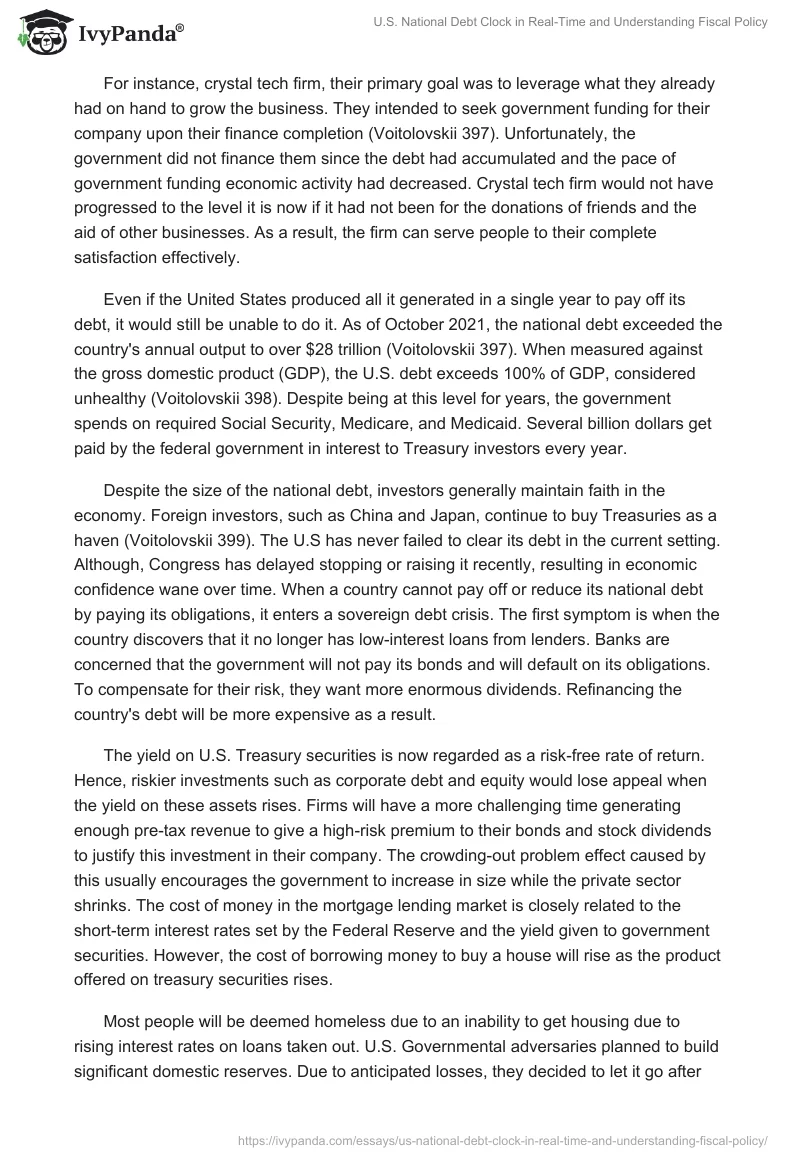The U.S. National Debt Clock displays the federal government’s outstanding debt. The public debt is represented by two-thirds of the clock in treasury bills, notes, and bonds, including people, corporations, and foreign governments. Thus, the government owes a third of the debt, including federal programs such as Social Security (Voitolovskii 393). The Debt Clock usually provides demographic data for the country, which helps determine where program funds may go.
The United States national debt comprises two categories of debt: public debt and intragovernmental debt. The public debt is the amount the government owes to Treasury investors (Voitolovskii 394). People from the United States, international investors, and foreign governments are among the investors. The federal government owes other government agencies intragovernmental debt. It caters to Social Security, government programs, and pensions in the United States.
The national debt level has long been a source of contention in U.S. domestic affairs. Given the amount of fiscal stimulus pushed into the U.S. economy over the last several years, it is easy to see why so many people are becoming concerned about this issue (Voitolovskii 395). Unfortunately, the way debt levels are communicated to the general public is frequently somewhat crying optic. Combining this issue with the reality that many people are unaware of how the national debt level impacts their everyday lives might result in a topic for debate.
The chance of the government defaulting on its debt service obligations rises as the national debt per capita increases; hence, the Treasury Department will have to raise the return on freshly issued Treasury securities to entice new investors. However, more tax money will have to be paid out as interest on the national debt, the amount of tax revenue available for other governmental services will be reduced. As financing for economic improvement projects becomes more onerous, this change in spending will cause individuals to have a poorer quality of living over time, resulting in significant impacts on businesspeople.
For instance, crystal tech firm, their primary goal was to leverage what they already had on hand to grow the business. They intended to seek government funding for their company upon their finance completion (Voitolovskii 397). Unfortunately, the government did not finance them since the debt had accumulated and the pace of government funding economic activity had decreased. Crystal tech firm would not have progressed to the level it is now if it had not been for the donations of friends and the aid of other businesses. As a result, the firm can serve people to their complete satisfaction effectively.
Even if the United States produced all it generated in a single year to pay off its debt, it would still be unable to do it. As of October 2021, the national debt exceeded the country’s annual output to over $28 trillion (Voitolovskii 397). When measured against the gross domestic product (GDP), the U.S. debt exceeds 100% of GDP, considered unhealthy (Voitolovskii 398). Despite being at this level for years, the government spends on required Social Security, Medicare, and Medicaid. Several billion dollars get paid by the federal government in interest to Treasury investors every year.
Despite the size of the national debt, investors generally maintain faith in the economy. Foreign investors, such as China and Japan, continue to buy Treasuries as a haven (Voitolovskii 399). The U.S has never failed to clear its debt in the current setting. Although, Congress has delayed stopping or raising it recently, resulting in economic confidence wane over time. When a country cannot pay off or reduce its national debt by paying its obligations, it enters a sovereign debt crisis. The first symptom is when the country discovers that it no longer has low-interest loans from lenders. Banks are concerned that the government will not pay its bonds and will default on its obligations. To compensate for their risk, they want more enormous dividends. Refinancing the country’s debt will be more expensive as a result.
The yield on U.S. Treasury securities is now regarded as a risk-free rate of return. Hence, riskier investments such as corporate debt and equity would lose appeal when the yield on these assets rises. Firms will have a more challenging time generating enough pre-tax revenue to give a high-risk premium to their bonds and stock dividends to justify this investment in their company. The crowding-out problem effect caused by this usually encourages the government to increase in size while the private sector shrinks. The cost of money in the mortgage lending market is closely related to the short-term interest rates set by the Federal Reserve and the yield given to government securities. However, the cost of borrowing money to buy a house will rise as the product offered on treasury securities rises.
Most people will be deemed homeless due to an inability to get housing due to rising interest rates on loans taken out. U.S. Governmental adversaries planned to build significant domestic reserves. Due to anticipated losses, they decided to let it go after assessing the country’s national debt and calculating interest rates. The government should think about the people’s economic well-being. The number of individuals living on the streets will be reduced as more people will be encouraged to take out loans.
However, as the value of a country’s currency is linked to its bonds, it also exerts downward pressure on the money. Foreign bond holders’ repayments are worthless as their currency’s value falls, resulting in a demand reduction even more as it raises interest rates. As the currency’s value drops, services and goods may become more expensive, leading to inflation. As a result, the country might raise taxes and cut spending to lower its debt. Both of these strategies are weapons of conflicting fiscal policy, and either might limit economic development. Cuts in spending, on the other hand, have their drawbacks.
I was sitting at work one afternoon when I began to feel a bit hungry. I was in the mood for a doughnut to give me a sugar rush to get me through the remainder of the day. In pursuit of the great donut, I stroll down the street and find myself in front of two doughnut shops, both of which were packed with customers who have identical donut appetites. On my left, the no-frills doughnut shop has trays of freshly made donuts precisely lined up behind the glass counter. Along with warm sugar-dusted cinnamon donuts, there were salted caramel donuts, jam-filled doughnuts, and various other tempting flavors.
On the other hand, customers were queuing up, ordering a half-dozen doughnuts, paying, and then departing. Meanwhile, the second location has the same flavor selection, but the donuts were more expensive. The shop was painted in bright, pastel hues. There was also light jazz music playing, a barista pouring coffee on the sparkling La Marzocco machine, and tiny seats and tables put up in and out of the store if someone did not want to go back to the office. Although the first business’s doughnut was less expensive, I preferred the second bakery because of its friendly, inviting atmosphere.
Work Cited
Voitolovskii, F. G. “U.S. Strategy in a Changing World Order: Challenges for Russia.” Herald of the Russian Academy of Sciences vol. 91, no. 4, 2021, pp. 393-402.


